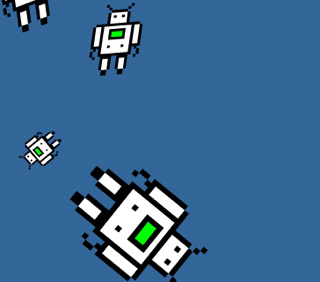Splash art originated in the 1940s in comics, where the term referred to a full page of visuals at the front of a book. Pages were designed to engage the reader's imagination along the lines of the comic's broader concept, while standing independent from the narrative. In the late 1990s, when the widespread use of the application Flash opened up new possibilities for animation and interactive media, the idea of the splash page migrated to web design. Online splash art brought visual excitement to a webpage when low modem speeds made it impractical to post large or moving images amid a site's textual content.
Rhizome introduced splash pages to its web site in 1998 in order to display artwork with greater immediacy....
Rhizome introduced splash pages to its web site in 1998 in order to display artwork with greater immediacy....
Launch Project 
 Light of Speed vs. Rhizome, 2000
Light of Speed vs. Rhizome, 2000
About
A flock of two-dimensional robots drifts down a blue screen. Roll over one, and a male or female symbol from public restrooms flashes, assigning a gender to the sexless machine. Click on a robot, and it emits a vibrating chord. David Crawford's exercise in Flash animation seems like a sharp contrast to Stop Motion Studies, his long-term project that explores modes of public behavior by using Flash MX to animate photographs of passengers on buses and trains. But the attention to identity and motion in Light of Speed vs. Rhizome hints at a common bond.
http://stopmotionstudies.net
http://stopmotionstudies.net